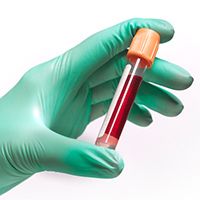
read time: 4 min
Health & Wellness, Sexual Health
As little as 3 decades ago, getting diagnosed with HIV was seen as a death sentence. Thanks to medical breakthroughs, however, HIV/AIDS has gone from a terminal diagnosis to a preventable chronic disease. So why is HIV still a major global public health crisis?1
The short answer: stigma. Judgment and shame surrounding diagnosis is still a major barrier for prevention and treatment, especially for men. If we want to prevent HIV in the general population, and especially in men as a higher-risk group, we need to understand where the stigma comes from and how we can counter it.
The quest for an easy, effective HIV/AIDS treatment
For a long time, the fight against AIDS was an uphill battle. While the first drug for treating AIDS was approved in 1987, treatment was burdensome. Many people dealt with adverse side effects, complicated medication schedules, and a rapid tolerance buildup that eventually made the drugs ineffective as long-term treatment.2
After years of progress, we saw a breakthrough in 2013 when the FDA approved a once-daily pill with a high barrier for resistance called dolutegravir. Since then, scientists have developed many options for daily HIV medication which can, when taken as prescribed, help a person’s viral load remain at undetectable levels, keeping their immune system strong. It can also significantly reduce the risk of transmitting HIV to someone else.3 While a diagnosis of HIV gave people a life expectancy of only a few years in the 1980s, many with HIV today are able to live long, healthy lives.4
Even better? We now have more than treatment options—we have preventive measures. PrEP, or pre-exposure prophylaxis, is a daily pill or bi-monthly injection that can actually reduce the risk of getting HIV from sex by 99% and from injection drug use by 74%. If exposed to HIV and taking PrEP as directed, the medication can stop HIV from taking hold and spreading through the body.5
The endurance of HIV stigma for men
So we now have personalized treatment options that can maintain health and reduce HIV transmission to partners, along with a pill that can prevent the contraction of HIV in the first place. Sounds like the fight against HIV/AIDS is over, right?
Unfortunately, barriers still exist that stop people from seeking and accessing the help they need. Today, there are over 1 million people in the US living with HIV.6 Gay, bisexual, and other men who have sex with men (MSM) account for about 66% of new infections every year, with a disproportionate amount of infections impacting men of color.7 The stigma against people living with HIV is still really strong, including within the MSM community. And that stigma is preventing some of the most vulnerable to the virus from getting the help they need.
Facing the social stigma around PrEP

Explaning the low rate of HIV testing for men
That enduring stigma is putting people at risk. In the US, 1 in 7 men with HIV doesn’t know they have it.13 Not knowing means they aren’t getting the treatments they need to stay healthy, and may be passing HIV to their partners without realizing it.

Ending HIV stigma starts with you
We may see the end of the HIV epidemic in our lifetime. Scientists are working on longer-acting HIV treatments that reduce the need for daily medication while continuing to search for a vaccine.14,15 In the meantime, though, a 2-pronged approach of talking more openly about living with HIV and encouraging more testing can help men overcome the HIV stigma and access the care they need.
Using preventive tools like PrEP and regular testing aren’t signs of weakness or promiscuity—they show you’re taking an active role in keeping you and your partners safe.
It’s important for men to address the PrEP stigma head-on, both to address their own internal bias and to create an open dialog with others in their community. Using preventive tools like PrEP and regular testing aren’t signs of weakness or promiscuity—they show you’re taking an active role in keeping you and your partners safe. If you’re sexually active, talk to your doctor about HIV prevention. You can get PrEP through your primary care provider or a local health clinic. Many health insurances or state programs cover the medication, and you may qualify for free PrEP.16
Even if you’re on PrEP, make testing for STDs a frequent part of your healthcare routine. PrEP is designed to protect you against HIV, but not any other sexually transmitted diseases. Having other STDs can actually put you at increased risk for HIV.17 Knowing your sexual health status gives you the power to protect yourself and others.
People with HIV can live long, healthy lives, and they deserve to live without shame. The more we talk about HIV prevention and the reality of living with HIV/AIDS, the more we can reduce the stigma surrounding preventive care and diagnosis.
References
1 HIV and AIDS.
World Health Organization. Accessed May 18, 2023. https://www.who.int/news-room/fact-sheets/detail/hiv-aids
2 Antiretroviral drug discovery and development.
National Institute of Allergy and Infectious Diseases. Accessed May 18, 2023. https://www.niaid.nih.gov/diseases-conditions/antiretroviral-drug-development
3 HIV and AIDS: medicines to help you.
US Food & Drug Administration. Accessed May 18, 2023. https://www.fda.gov/consumers/free-publications-women/hiv-and-aids-medicines-help-you#HIV_Medicines
4 Growing older with HIV.
HIV.gov. Accessed May 18, 2023. https://www.hiv.gov/hiv-basics/living-well-with-hiv/taking-care-of-yourself/aging-with-hiv/
5 How effective is PrEP?
Centers for Disease Control and Prevention. Accessed May 18, 2023. https://www.cdc.gov/hiv/basics/prep/prep-effectiveness.html
6 Statistics overview.
Centers for Disease Control and Prevention. Accessed May 18, 2023. https://www.cdc.gov/hiv/statistics/overview/index.html
7 Impact on racial and ethnic minorities.
HIV.gov. Accessed May 18, 2023. https://www.hiv.gov/hiv-basics/overview/data-and-trends/impact-on-racial-and-ethnic-minorities/
8 Elion RA, Kabiri M, Mayer KH, et al. Estimated impact of targeted pre-exposure prophylaxis: strategies for men who have sex with men in the United States. Int J Environ Res Public Health. 2019;16(9):1592. doi: 10.3390/ijerph16091592
9 Stephenson R, Chavanduka T, Sullivan S, et al. Pre-exposure prophylaxis stigma and beliefs in the efficacy of pre-exposure prophylaxis: an analysis of a cross-sectional survey of male couples in the United States. Journal of the Association of Nurses in AIDS Care. 2022;33(4):406-420. doi: 10.1097/JNC.0000000000000315
10 DiCarlo AL, Mantell JE, Remien RH, et al. ‘Men usually say that HIV testing is for women’: gender dynamics & perceptions of HIV testing in Lesotho. Cult Health Sex. 2014;16(8):867-82. doi: 10.1080/13691058.2014.913812
11 Ha JH, Van Lith LM, Mallalieu EC, et al. Gendered relationship between HIV stigma and HIV testing among men and women in Mozambique: a cross-sectional study to inform a stigma reduction and male-targeted HIV testing intervention. BMJ Open. 2019; 9(10):e029748. doi: 10.1136/bmjopen-2019-029748
12 Quinn C, Kadengye DT, Johnson CC, et al. Who are the missing men? Characterising men who never tested for HIV from population-based surveys in six sub-Saharan African countries. Journal of the International AIDS Society. 2019;22(10):e25398. doi: 10.1002/jia2.25398
13 HIV and men.
Centers for Disease Control and Prevention. Accessed May 18, 2023. https://www.cdc.gov/hiv/group/gender/men/index.html
14 Future directions for HIV treatment research.
National Institute of Allergy and Infectious Diseases. Accessed May 18, 2023. https://www.niaid.nih.gov/diseases-conditions/future-hiv-treatment
15 Progress toward an eventual HIV vaccine.
National Institutes of Health. Accessed June 8, 2023. https://www.nih.gov/news-events/nih-research-matters/progress-toward-eventual-hiv-vaccine
16 Ready, set, PrEP: find out if you qualify to enroll for free PrEP medication.
Department of Health & Human Serives. Accessed May 18, 2023. https://readysetprep.hiv.gov/
17 STDs and HIV — CDC detailed fact sheet. Centers for Disease Control and Prevention. Accessed May 18, 2023. https://www.cdc.gov/std/hiv/stdfact-std-hiv-detailed.htm









